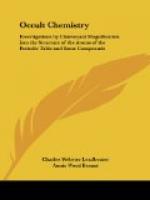The building of a gaseous atom of hydrogen may be traced downward from E 1, and, as stated above, the lines given in the diagram are intended to indicate the play of the forces which bring about the several combinations. Speaking generally, positive bodies are marked by their contained atoms setting their points towards each other and the centre of their combination, and repelling each other outwards; negative bodies are marked by the heart-shaped depressions being turned inwards, and by a tendency to move towards each other instead of away. Every combination begins by a welling up of force at a centre, which is to form the centre of the combination; in the first positive hydrogen combination, E 2, an atom revolving at right angles to the plane of the paper and also revolving on its own axis, forms the centre, and force, rushing out at its lower point, rushes in at the depressions of two other atoms, which then set themselves with their points to the centre; the lines are shown in +b, right-hand figure. (The left-hand figure indicates the revolution of the atoms each by itself.) As this atomic triad whirls round, it clears itself a space, pressing back the undifferentiated matter of the plane, and making to itself a whirling wall of this matter, thus taking the first step towards building up the chemical hydrogen atom. A negative atomic triad is similarly formed, the three atoms being symmetrically arranged round the centre of out-welling force. These atomic triads then combine, two of the linear arrangement being attracted to each other, and two of the triangular, force again welling up and forming a centre and acting on the triads as on a single atom, and a limiting wall being again formed as the combination revolves round its centre. The next stage is produced by each of these combinations on E 3 attracting to itself a third atomic triad of the triangular type from E 2, by the setting up of a new centre of up-welling force, following the lines traced in the combinations of E 4. Two of these uniting, and their triangles interpenetrating, the chemical atom is formed, and we find it to contain in all eighteen ultimate physical atoms.
The next substance investigated was oxygen, a far more complicated and puzzling body; the difficulties of observation were very much increased by the extraordinary activity shown by this element and the dazzling brilliancy of some of its constituents. The gaseous atom is an ovoid body, within which a spirally-coiled snake-like body revolves at a high velocity, five brilliant points of light shining on the coils. The snake appears to be a solid rounded body, but on raising the atom to E 4 the snake splits lengthwise into two waved bodies, and it is seen that the appearance of solidity is due to the fact that these spin round a common axis in opposite directions, and so present a continuous surface, as a ring of fire can be made by whirling a lighted stick. The brilliant bodies seen in the atom are on the crests of the waves in the positive




